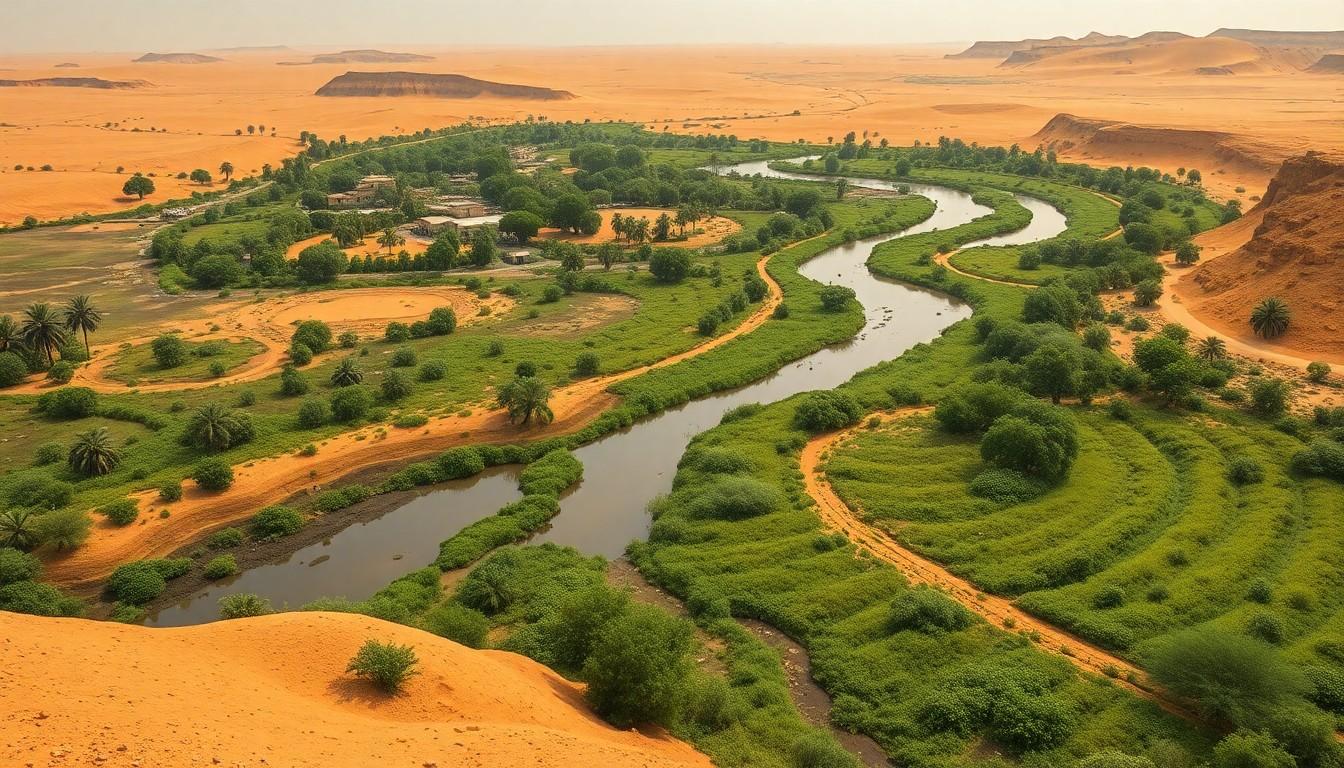Ancient Egypt’s Indigenous name, “Khemit,” holds profound significance in understanding the true essence of this remarkable civilization. While most people know this land as Egypt, the term Khemit refers to the “Black Land” – a reference to the rich, dark soil deposited by the annual flooding of the Nile River.
Beyond its literal meaning, Khemit represents a sophisticated spiritual and scientific legacy that intrigues scholars and enthusiasts worldwide. This ancient culture’s understanding of mathematics, astronomy, and natural sciences laid the groundwork for many modern scientific principles. The indigenous Khemitian perspective offers a fascinating alternative to conventional Egyptology, revealing more profound insights into the mysteries of pyramids, hieroglyphs, and sacred ceremonies.
What is Khemit: Ancient Name for Egypt
Khemit, alternatively spelled as Kemet, is the Indigenous name for ancient Egypt, derived from the fertile black soil deposits along the Nile River. The term originates from the ancient Egyptian language, where “khem” translates to “black” and “it” denotes “land” or “place.”
Geographic Significance
The name reflects the region’s distinctive agricultural landscape, characterized by:
- Rich black silt deposits from annual Nile floods
- Fertile valleys contrasting with surrounding desert regions
- Agricultural zones supporting civilization development
Cultural Identity
The indigenous population identified themselves through specific cultural markers:
- Self-reference as “Remetch en Kemet” (People of the Black Land)
- Cultural practices tied to the Nile’s natural cycles
- Distinct societal structures rooted in agricultural prosperity
| Time Period | Name Usage | Cultural Context |
|---|---|---|
| Old Kingdom (2613-2181 BCE) | Primary reference | Pyramid building era |
| Middle Kingdom | Continued usage | Administrative period |
| New Kingdom | Traditional name | Imperial expansion |
Historical Context
Khemit’s historical significance manifests in multiple aspects:
- A central role in North African civilization development
- Cultural influence on Mediterranean societies
- Connection to broader African cultural traditions
- Foundation for Mathematical Scientific Advancement
This indigenous designation emphasizes Egypt’s African roots, providing insights into the civilization’s self-identity distinct from later Greek or Roman interpretations. Khemit places ancient Egyptian civilization firmly within its African cultural context, highlighting indigenous knowledge systems predating external influences.
Origin and Etymology of Khemit

“Khemit” originates from the ancient Egyptian word km, representing the Indigenous name for Ancient Egypt. The word combines km, meaning “black,” with the feminine suffix—t.
Black Land Connection
“Khemit” translates directly to “the Black Land,” describing the dark alluvial soil deposited by the Nile River’s annual floods. This fertile black soil created ideal conditions for agriculture along the river banks, establishing the foundation for ancient Egyptian civilization. The dark sediment deposits distinguished the cultivated areas from the surrounding desert landscape, making the term “Black Land” a precise geographical descriptor.
- Temple inscriptions describing agricultural cycles
- Royal decrees referencing the kingdom’s territories
- Religious texts highlighting the sacred nature of the land
- Administrative documents recording land management practices
| Historical Period | Usage of Term | Primary Reference |
|---|---|---|
| Old Kingdom | kmt in hieroglyphs | Temple inscriptions |
| Middle Kingdom | Expanded use in texts | Administrative records |
| New Kingdom | Widespread documentation | Royal documents |
Khemit’s Role in Ancient Egyptian Culture

Khemit was the cornerstone of ancient Egyptian civilization, extending beyond its modern borders into Africa’s heartland near Khartoum. The region’s identity centered around the Nile River’s annual flooding cycle, which created fertile black soil essential for agricultural prosperity.
Religious Significance
The fertile black soil of Khemit held profound religious significance in ancient Egyptian belief systems. The annual Nile flooding directly connected agricultural abundance and divine blessings, linking the physical landscape to spiritual practices. The name “Black Land” represented the literal soil color and symbolic representations of fertility, rebirth, and abundance in religious ceremonies.
Social Structure
Khemit’s social organization developed around agricultural communities that emerged approximately 7,000 years ago. The society operated through a hierarchical system with:
- Agricultural Workers – Forming the foundation of the economic structure through crop cultivation
- Village Leaders – Managing local resources and coordinating farming activities
- Religious Officials – Interpreting natural cycles and performing ceremonies
- Regional Administrators – Overseeing multiple farming communities
- Royal Authority – Controlling resource distribution and agricultural planning
This social arrangement reflected the practical need to manage the fertile Nile Valley while maintaining order across Khemit’s extensive territories from Mediterranean coastal regions to southern African lands. The agricultural calendar shaped the region’s social roles, responsibilities, and community relationships.
Key Archaeological Sites in Khemit

Archaeological sites across Khemit (Ancient Egypt) reveal extensive cultural developments spanning multiple dynasties. These locations preserve vital historical records through architectural monuments, burial grounds, and ceremonial complexes.
Major Cities and Monuments
Abydos is a principal sacred city featuring multiple temple complexes, including the significant Umm el-Qa’ab necropolis. The site contains the tomb of Menes, the first pharaoh of unified Egypt, alongside royal burials from the Early Dynastic period. Temple construction at Abydos continued through the Thirtieth Dynasty, with Nectanebo I adding the final central structure.
Saqqara functions as Memphis’s primary necropolis, distinguished by the Step Pyramid of Djoser from the Third Dynasty. This architectural marvel, designed by Imhotep, represents the earliest known pyramid structure in Khemit.
Recent Discoveries
Recent excavations at Saqqara have uncovered:
| Year | Discovery | Significance |
|---|---|---|
| 2020 | 100+ sealed sarcophagi | Largest discovery of its kind |
| 2021 | Temple of Queen Nearit | New insights into royal worship |
| 2022 | Burial shaft complex | Evidence of elite burial practices |
- Ground-penetrating radar surveys revealing hidden chambers
- 3D scanning of hieroglyphic inscriptions
- Digital mapping of underground tomb networks
- Chemical analysis of preserved organic materials
Legacy of Khemit in Modern Egypt
Modern Egypt’s cultural identity remains deeply rooted in the legacy of Khemit (ancient Egypt). The impact manifests in three distinct areas:
Cultural Identity
Khemit’s heritage forms the cornerstone of modern Egyptian identity. Ancient symbols appear on national monuments, government buildings, and official documents. Archaeological sites like the pyramids are powerful cultural anchors, connecting present-day Egyptians to their ancestral civilization.
Philosophical Principles
The concept of Ma’at, representing cosmic order and balance from ancient Khemit, influences contemporary Egyptian society in several ways:
- Legal frameworks incorporating principles of justice and equality
- Social values emphasizing communal harmony
- Cultural practices reflecting the spiritual balance
- Racial perspectives promoting equality and inclusion
Linguistic Heritage
The ancient Egyptian language has left an enduring mark on modern vocabulary:
| Modern Term | Khemitic Origin | Original Meaning |
|---|---|---|
| Chemistry | Khemia | Earth transmutation |
| Alchemy | Al-Khemia | The black art |
| Coptic | Ancient Egyptian | Religious texts |
These linguistic connections demonstrate the profound influence of Khemit’s knowledge systems on modern scientific terminology. The preservation of the Coptic language in religious contexts maintains a direct link to ancient Egyptian linguistic traditions.
Integrating Khemitic elements extends beyond symbolic representations into practical aspects of Egyptian life. Traditional medicine practices, architectural principles, and agricultural methods continue to reflect knowledge passed down from ancient times. Local craftsmen still employ techniques inherited from their Khemitic ancestors in pottery, weaving, and metalwork.
Final Words
Khemit stands as a testament to the enduring legacy of ancient Egyptian civilization. The name reveals profound connections to the land’s fertile soil and the spiritual beliefs that shaped a remarkable society. Modern archaeological discoveries continue to unveil new layers of understanding about this fascinating civilization.
The influence of Khemit extends far beyond its historical boundaries, shaping modern Egypt’s cultural identity, philosophical principles, and scientific understanding. Through ongoing research and technological advancements, we’re gaining deeper insights into this remarkable civilization that flourished along the banks of the Nile River.

